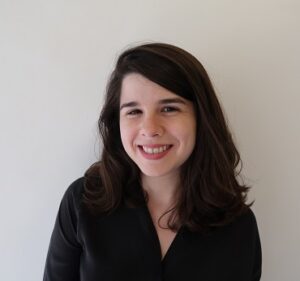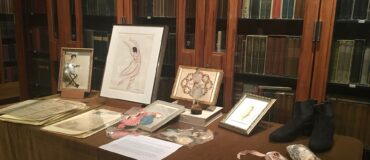By Carolina Meneses
Carolina Meneses is Dance/USA’s first Dance Archiving & Preservation Fellow. Her Fellowship, from July-September 2018, is hosted by UCLA Library Special Collections, and her practicum site is Lula Washington Dance Theatre. Read more about the Fellowship program here. This is the first of six posts from Carolina’s 2018 summer blog. Read the second part here.
August 3, 2018
“Perhaps one of the best perks about being an archivist is being able to read other people’s mail.”

Lobby of the Library Special Collections, Charles E. Young Research Library, UCLA, showing current exhibition titled, “Songs of America: Themes in Popular American Music”
I was excited to finally start my Dance/USA fellowship at UCLA Library Special Collections (LSC). Going into the experience I wasn’t sure what to expect, but I was delighted by how beautiful the space was and how friendly and welcoming its staff. Genie Guerard, Curator and Manuscripts Librarian, and also my Dance/USA host and mentor for the fellowship, has been super helpful in getting me up to speed with everything and helping me understand what to expect. I also met with Jasmine Jones, the Head of Processing for Library Special Collections, who trained me and gave me an overview of the different projects I would be working on during the first part of my fellowship at UCLA. She assigned me some reading and then set me up with my first project with the Ruth St. Denis papers, 1880-1968.

Drawing of Ruth St. Denis as the Madonna, Ruth St. Denis papers (Collection 1031). UCLA Library Special Collections, Charles E. Young Research Library, UCLA.
This was my first introduction to Ruth St. Denis, a pioneer in American modern dance whose work was inspired by Eastern philosophy and culture. Apparently, it all started when she came across an image of the goddess Iris on an advertisement for Egyptian Deities cigarettes. For decades, she was greatly influential as a modern dancer who combined dance and spirituality.
LSC holds a collection of Ruth St. Denis’s personal papers, which is made up of her journals, correspondence, writings, choreographic notes, and more. I have been tasked with going through a series of Ruth’s correspondence to verify that what is physically inside the folders matches the descriptions in the finding aid, which is a document containing everything from processing notes to information about how a collection is arranged. The collection was arranged at the folder level and each folder was given a title by the archivist.

Correspondence, Ruth St. Denis papers (Collection 1031). UCLA Library Special Collections, Charles E. Young Research Library, UCLA.
After going through the 17 boxes in the series, I found that most of the folder titles need updated description in order to better assist researchers with identifying their contents. Each folder contains letters to and by diverse people and organizations, discussing a variety of topics. Dates were the most common thread per folder. I presented my findings to Jasmine and together we decided to list just the date ranges of the letters in each folder, and to name the correspondents and main topics found in those folders within scope notes that cover each series or subseries.
I have been editing the Ruth St. Denis finding aid via ArchiveSpace, a software for managing archival collections. It’s my first time using ArchiveSpace so I have been learning as I go.

Correspondence, Ruth St. Denis papers (Collection 1031). UCLA Library Special Collections, Charles E. Young Research Library, UCLA.
Perhaps one of the best perks about being an archivist is being able to read other people’s mail. However, as much as I have been tempted to read every single letter in the Ruth St. Denis correspondence series, I’ve held back since time is of the essence. It’s important that the collection becomes available for the user as soon as possible. Still, I haven’t been able to resist reading from time to time. There are of course some heartfelt love letters from her husband Ted Shawn. I have also come across a series of “history letters” which were written by Ruth St. Denis to keep people informed of her activities and plans. There’s one from December 29, 1944 where she goes through the course of her day, beginning with her waking up to her cat Tiger: “It is now about 7:30 A.M. So he brushes his whiskers along my chin and purrs a little throaty baritone purr – and sinks a claw discretely, always the gentleman, into my shoulder and I begin to stir.”

Feuillet, Raoul-Auger, “Chorégraphie, ou, L’art de décrire la dance par caracteres, figures et signes desmonstratifs…” Paris: Chez le sr.Dezais, 1713.
Another really interesting thing I’ve been exposed to is participating in donor visits. Last week I attended a meeting with a dance performer who is interested in donating his collection to UCLA. Genie did a wonderful show-and-tell of some of LSC’s dance treasures for him. I also went with Genie and another LSC archivist, Kelly Besser, to visit an archive that is being donated to LSC from a major Los Angeles performing arts center. Final plans are being made for processing their collection on-site in advance of their deposit to UCLA. Both were fascinating opportunities to see how relationships are formed with potential donors and the way collections are acquired.
I’m really looking forward to the next few weeks at UCLA, followed by my practicum with Lula Washington Dance Theatre.
All photos by Carolina Meneses

Carolina Meneses is pursuing a master’s degree in library and information science at UCLA, specializing in archival studies. A second generation Cuban-American from Miami, she received her BA in comparative literature at Smith College where she focused on the intersection of memory, dance, and language. After college, she participated in an archival internship with a dance company based in New York City, which became the foundation for her interest in the contradictory nature of preserving the ephemerality of dance performance for research and reproduction. Carolina is also the recipient of a Mosaic Scholarship from the Society of American Archivists, which provides support for minority students pursuing graduate studies in archival science.
____
We accept submissions on topics relevant to the field: advocacy, artistic issues, arts policy, community building, development, employment, engagement, touring, and other topics that deal with the business of dance. We cannot publish criticism, single-company season announcements, and single-company or single artist profiles. Additionally, we welcome feedback on articles. If you have a topic that you would like to see addressed or feedback, please contact communications@danceusa.org.
Disclaimer: Opinions expressed in guest posts do not necessarily represent the viewpoints of Dance/USA.




